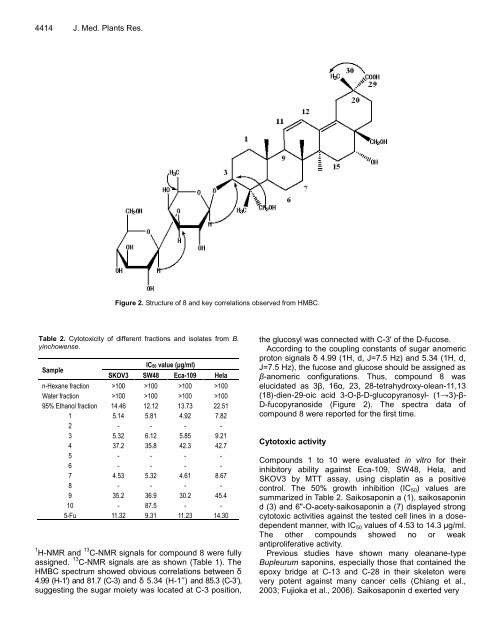Download Complete Issue (4740kb) - Academic Journals
Download Complete Issue (4740kb) - Academic Journals
Download Complete Issue (4740kb) - Academic Journals
Create successful ePaper yourself
Turn your PDF publications into a flip-book with our unique Google optimized e-Paper software.
4414 J. Med. Plants Res.<br />
Figure 2. Structure of 8 and key correlations observed from HMBC.<br />
Table 2. Cytotoxicity of different fractions and isolates from B.<br />
yinchowense.<br />
Sample<br />
SKOV3<br />
IC50 value (μg/ml)<br />
SW48 Eca-109 Hela<br />
n-Hexane fraction >100 >100 >100 >100<br />
Water fraction >100 >100 >100 >100<br />
95% Ethanol fraction 14.46 12.12 13.73 22.51<br />
1 5.14 5.81 4.92 7.82<br />
2 - - - -<br />
3 5.32 6.12 5.85 9.21<br />
4 37.2 35.8 42.3 42.7<br />
5 - - - -<br />
6 - - - -<br />
7 4.53 5.32 4.61 8.67<br />
8 - - - -<br />
9 35.2 36.9 30.2 45.4<br />
10 - 87.5 - -<br />
5-Fu 11.32 9.31 11.23 14.30<br />
1 H-NMR and 13 C-NMR signals for compound 8 were fully<br />
assigned. 13 C-NMR signals are as shown (Table 1). The<br />
HMBC spectrum showed obvious correlations between δ<br />
4.99 (H-1') and 81.7 (C-3) and δ 5.34 (H-1’’) and 85.3 (C-3’),<br />
suggesting the sugar moiety was located at C-3 position,<br />
the glucosyl was connected with C-3' of the D-fucose.<br />
According to the coupling constants of sugar anomeric<br />
proton signals δ 4.99 (1H, d, J=7.5 Hz) and 5.34 (1H, d,<br />
J=7.5 Hz), the fucose and glucose should be assigned as<br />
β-anomeric configurations. Thus, compound 8 was<br />
elucidated as 3β, 16α, 23, 28-tetrahydroxy-olean-11,13<br />
(18)-dien-29-oic acid 3-O-β-D-glucopyranosyl- (1→3)-β-<br />
D-fucopyranoside (Figure 2). The spectra data of<br />
compound 8 were reported for the first time.<br />
Cytotoxic activity<br />
Compounds 1 to 10 were evaluated in vitro for their<br />
inhibitory ability against Eca-109, SW48, Hela, and<br />
SKOV3 by MTT assay, using cisplatin as a positive<br />
control. The 50% growth inhibition (IC50) values are<br />
summarized in Table 2. Saikosaponin a (1), saikosaponin<br />
d (3) and 6"-O-acety-saikosaponin a (7) displayed strong<br />
cytotoxic activities against the tested cell lines in a dosedependent<br />
manner, with IC50 values of 4.53 to 14.3 μg/ml.<br />
The other compounds showed no or weak<br />
antiproliferative activity.<br />
Previous studies have shown many oleanane-type<br />
Bupleurum saponins, especially those that contained the<br />
epoxy bridge at C-13 and C-28 in their skeleton were<br />
very potent against many cancer cells (Chiang et al.,<br />
2003; Fujioka et al., 2006). Saikosaponin d exerted very

















